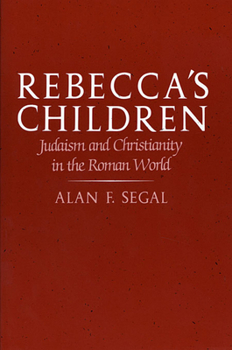Rebecca's Children: Judaism and Christianity in the Roman World
Select Format
Select Condition 
Book Overview
Renowned scholar Alan F. Segal offers startlingly new insights into the origins of rabbinic Judaism and Christianity. These twin descendants of Hebrew heritage shared the same social, cultural, and ideological context, as well as the same minority status, in the first century of the common era.
Through skillful application of social science theories to ancient Western thought, including Judaism, Hellenism, early Christianity, and a host of other sectarian beliefs, Segal reinterprets some of the most important events of Jewish and Christian life in the Roman world. For example, he finds: -- That the concept of myth, as it related to covenant, was a central force of Jewish life. The Torah was the embodiment of covenant both for Jews living in exile and for the Jewish community in Israel.-- That the Torah legitimated all native institutions at the time of Jesus, even though the Temple, Sanhedrin, and Synagogue, as well as the concepts of messiah and resurrection, were profoundly affected by Hellenism. Both rabbinic Judaism and Christianity necessarily relied on the Torah to authenticate their claim on Jewish life.
-- That the unique cohesion of early Christianity, assuring its phenomenal success in the Hellenistic world, was assisted by the Jewish practices of apocalypticism, conversion, and rejection of civic ritual.
-- That the concept of acculturation clarifies the Maccabean revolt, the rise of Christianity, and the emergence of rabbinic Judaism.
-- That contemporary models of revolution point to the place of Jesus as a radical.
-- That early rabbinism grew out of the attempts of middle-class Pharisees to reach a higher sacred status in Judea while at the same time maintaining their cohesion through ritual purity.
-- That the dispute between Judaism and Christianity reflects a class conflict over the meaning of covenant. The rising turmoil between Jews and Christians affected the development of both rabbinic Judaism and Christianity, as each tried to preserve the partly destroyed culture of Judea by becoming a religion. Both attempted to take the best of Judean and Hellenistic society without giving up the essential aspects of Israelite life. Both spiritualized old national symbols of the covenant and practices that consolidated power after the disastrous wars with Rome. The separation between Judaism and Christianity, sealed in magic, monotheism, law, and universalism, fractured what remained of the shared symbolic life of Judea, leaving Judaism and Christianity to fulfill the biblical demands of their god in entirely different ways.
Format:Paperback
Language:English
ISBN:0674750764
ISBN13:9780674750760
Release Date:January 1986
Publisher:Harvard University Press
Length:224 Pages
Weight:0.76 lbs.
Dimensions:0.6" x 6.2" x 9.3"
Customer Reviews
2 ratings
I liked it too
Published by Thriftbooks.com User , 21 years ago
Unlike the only other reviewer so far, I read this book from a Jewish perspective - that is, primarily looking for insight about the evolution of Judaism. I was not disappointed. Segal argues that classical, rabbinic Judaism (as enunciated in the Talmud and post-Talmud halacha) did not arise fully formed from Sinai. Rather, it arose out of the Pharisees, which in turn was just one sect out of many (though probably the most popular sect) until the Second Temple was destroyed in 70. Segal suggests that the dominance of the Mishnah (a law code written by the Pharisees' intellectual heirs, which was adopted by nearly all Jews) arose not just because it was intellectually compelling but for political reasons: the Romans had an interest in a unified Jewish community governed by one law, the Mishnah, and governed by rabbis who did not expect the Messiah to come any time soon. Interesting theory, though it doesn't explain why the Mishnah survived Jewish movement away from Israel.
Claiming Our Religious Sibling
Published by Thriftbooks.com User , 24 years ago
The first five chapters of Professor Segal's book contain little that is new. However, since the goal of this or any other academic text is truth rather than novelty, the book is still quite useful. In those first five chapters, Segal more than adequately summarizes the curricula of many a good undergraduate survey of religion, or comparative religion course. The material that Professor Segal presents on Palestinian cultures, politics, the life and message of Jesus of Nazareth, the role of Paul of Tarsus, and the ascendancy of rabbinical Judaism is not new. However, he does bring all that material together in one book that forms a handy reference for any would-be Biblical or Talmudic scholar.Professor Segal's most valuable contribution occurs in the last two chapters of his book, where he demonstrates that rabbinical Judaism and Christianity are (fraternal) twin religions born of the same political, social, and religious stimuli. Facing the crises of the wars of independence begun in 66 and 132 c.e., and their consequences, the religious and political systems which centered on the temple at Jerusalem were no longer viable. Thus, Christianity (which in many ways was still a Jewish sect) traveled one road to survival, while rabbinical Judaism took another. The result was two different religions. Nevertheless, Professor Segal does well to remind us that those religions were born of one mother: historical, pre-rabbinical, temple-centered Judaism. Because Segal's claim is true, it is incumbent upon all Christians and Jews to realize that the differences between them are not schisms between believers and infidels, but a continuing discussion within the household of faith.






